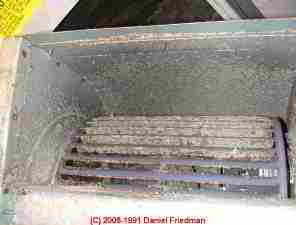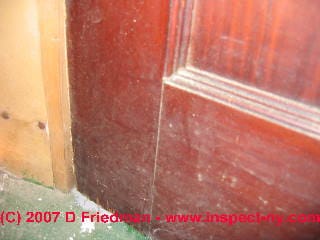 Find light-colored, hard-to-see mold indoors
Find light-colored, hard-to-see mold indoors
- POST a QUESTION or COMMENT about how to find light colored, hard to see mold contamination in buildings
Light colored toxic or allergenic mold contamination:
This article explains how to find and test for light or hard-to-see mold growth on building surfaces. The photo at page top shows a hard-to-see light-colored (possibly toxic) mold on the surface of an interior door. It is easy to miss large areas of light colored mold like this unless a careful inspection is made and careful use of light is applied.
Too many "mold inspectors" are quick to test the obvious "black molds" found on building surfaces while they may fail to find and identify possibly more harmful mold species simply because they ignored the light-colored mold growth. This document describes how to find mold and test for mold in buildings, including how and where to collect mold samples using adhesive tape - an easy, inexpensive, low-tech but very effective mold testing method.
InspectAPedia tolerates no conflicts of interest. We have no relationship with advertisers, products, or services discussed at this website.
Spotting light colored, hard to see, toxic molds indoors
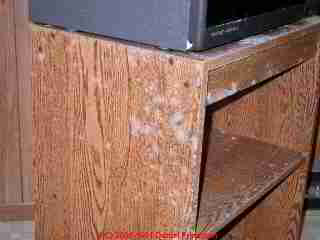 Other mold species are light in color or nearly invisible when growing on an interior surface
unless you look carefully. This desk sat in a wet basement for only two months yet it was rapidly
covered with a toxic mold, Aspergillus niger. Aspergillus molds indoors can be difficult to see.
Other mold species are light in color or nearly invisible when growing on an interior surface
unless you look carefully. This desk sat in a wet basement for only two months yet it was rapidly
covered with a toxic mold, Aspergillus niger. Aspergillus molds indoors can be difficult to see.
This procedure helps identify the presence of or locate the probable sources of mold reservoirs in buildings, and helps decide which of these need more invasive, exhaustive inspection and testing.
A. niger spores are tiny and are easily made airborne by the smallest disturbance. The basement housing this moldy chest had Aspergillus levels in air enormously higher than the outdoor sample.
Aspergillus mold growth on furniture
We find as much or more Penicillium/Aspergillus in houses than Stachybotrys, but these light green, gray or tan mold colonies are more difficult to see if you don't know how to look.
To check more carefully and thus more successfully for mold, shine your flashlight along the wall surface in an area that has been damp or wet.
Don't shine it right at the wall or you won't see much. Look where things have been wet or damp, regardless of whether it was a single event (washer flood) or one that happens at every rainstorm.
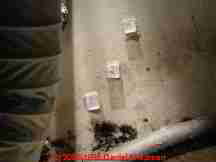
Keep in mind that different molds like different moisture, temperature, and food.
Watch out: One reason that S. chartarum has been "over-reported" as a problem in some studies is that the field "experts" didn't look for lighter molds, and maybe they didn't even carry a flash light. The photo here shows three tape samples being taken from different heights on a laundry room wall.
Three different mold species were found, one in each area. Only the lowest black mold was obvious.
In this wall test of three molds which were growing quite close together, I've marked each tape sample so that you can see where it was on the wall. #1 =Stachybotrys chartarum, #2 = Ulocladium chartarum, #3 = Aspergillus sp.. - it is this third mold which, in a larger quantity, would be airborne and more likely to bother building occupants.
Yet nearly 100% of home owners and 80% of industrial hygienists and 90% of home inspectors who send mold samples to our lab are going to tape-sample only the "dark mold" on this wall.
Why are there three different genera/species on this drywall? Most likely because each of them prefers a different moisture level in the paper which they're digesting. I
can generally track the mold genera up the wall as a function of the moisture gradients in the wall. When a wall has been wet because of wet floor conditions, the drywall and in-cavity wall insulation will be wettest at the wall bottom.
At MOLD LEVEL REPORTING we explain the errors you can expect if you do not choose a properly-representative area of a surface when collecting mold or dust samples and
at MOISTURE GRADIENTS & MOLD we explain why we find different mold genera/species at different locations on moldy drywall.
Be sure to review our notes above on use of lighting at
USE a FLASHLIGHT to FIND MOLD ince if you don't know exactly how to use a flashlight, as simple as it seems, you're not going to find important light-colored molds in buildings.
Photo of light-colored mold inside of a Florida air conditioning air handler unit above, courtesy of Mark Cramer, Tampa.
Also see MOLD in BUILDINGS and
see MOLD GROWTH on SURFACES for an index of what mold genera/species are frequently found on various building surfaces and materials.
For an atlas of building molds and for more microphotographs of building mold samples observed in our laboratory,
see MOLD ATLAS & PARTICLES INDEX.
Reader Comments, Questions & Answers About The Article Above
Below you will find questions and answers previously posted on this page at its page bottom reader comment box.
Reader Q&A - also see RECOMMENDED ARTICLES & FAQs
On 2022-11-03 by Anonymous - light, hard to see mold on interior doors means what?
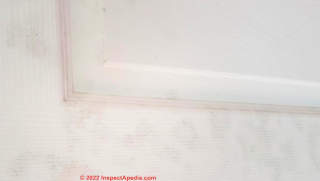 @InspectApedia-911, Thank you so much for everything; I will continue reading. To think that a week ago I couldn't even stand to look at pictures of mold! Growth through adversity!
@InspectApedia-911, Thank you so much for everything; I will continue reading. To think that a week ago I couldn't even stand to look at pictures of mold! Growth through adversity!
On 2022-11-03 by InspectApedia-911 (mod)
@Anonymous,
It sounds like you're on a reasonable course of action.
In this article series you will see advice on mold prevention as well as mold clean up as well as when and how to investigate building cavities for hidden reservoirs of mold.
On 2022-11-03 by Anonymous - remove the mold, fix its cause
@InspectApedia-911, I wish I could believe that, but I think the problem is that it's a small country with a lot of mold.
The few qualified people are busy with bigger jobs and trying to be nice by popping in for three minutes and telling me everything is probably fine. But it's just not that reassuring if they don't actually look.
If there's anything I've learned from you, it's that I have to find the source of the excess moisture, and ignoring it won't make it go away.
And if I had been as persistent about my guttering, which I knew was going to be a problem, I probably wouldn't be in this position now.
On 2022-11-02 by InspectApedia-911 (mod) - don't let fear cost you more than is appropriate in mold cleanup
@Anonymous,
Sounds as if people are trying to be ethical about not pouring your money over the problem.
Search this website for "OTHER PEOPLE'S MONEY" to read details.
On 2022-11-02 by Anonymous - excess moisture due to prolonged gutter failure
@InspectApedia-911, Yes, that sounds sensible. In this case the mold was on both sides of the doors. However, I didn't find any on the top and side edges, which were the only parts of the door that were painted (not just factory-primed).
I couldn't get under the bottom edge very well, which I'm concerned about - closest to the floor.
I didn't mention this before, but I suspect the original cause of the excess moisture was rain getting into our crawlspace due to a prolonged guttering failure. The guttering has been fixed, but I am having a hard time getting a professional opinion about what the condition of the crawlspace is now.
Everyone I consult seems prepared to wait and see if things get out of control before really investigating, but I live here and I'm determined to get to the bottom of this before that happens.
Anyway, thank you very much again for taking the time to answer my questions. It's incredibly generous of you. All the best.
On 2022-11-02 by InspectApedia-911 (mod) - is mold on hidden side of surface or only on the visible side
@Anonymous,
A central question when you see mold on building surfaces indoors is whether it's on the hidden side of those surfaces or only on the room side.
For example, if there's a light mold deposit on painted wood trim, and if I don't suspect mold in the wall cavity or ceiling cavity I would indeed clean the trim and possibly, when repainting, include a fungicide additive in my paint.
Following that of course we want to identify the source of moisture and fix that.
On the other hand, if there's mold on drywall, generally we need to remove that moldy drywall as well as explore the wall cavity or ceiling cavity that it covered.
On 2022-11-02 by Anonymous - mold contamination on doors is diffuse & hard to see
@InspectApedia-911, Thank you so much. The picture really isn't blurry, the mold is just faint and diffuse. Unfortunately, there is more mold than is pictured. That's a close-up of a part of one door.
The little grey marks are present on the front and back of three different doors (identical, bought in the same place at the same time), and concentrated at the bottom. I suppose there's more moisture nearer the floor.
I first saw the mold about six weeks ago and wiped it off, hoping it was just dirt - then it grew back.
That's when I called the inspector. He says I can just paint them and move on now that they're clean, but do you think I should be concerned about the fact that I cleaned them before and the mold grew back so fast?
I could just get rid of them. Just cleaning and painting them has already cost more than what I paid for them.
Nothing else inside the house seems moldy right now, except possibly a wooden window frame I'm having checked as soon as possible.
Thank you very much again for your advice!
On 2022-11-01 by InspectApedia-911 (mod)
@Anonymous,
I suspect that if other things in the home are moldy it's in their own right: having supported mold growth from what came in from outdoors; all mold is everywhere, all the time. What makes it grow are local conditions.
So if you're in doubt about other surfaces or materials and they smell moldy or look moldy, some cleaning is in order. Else, not.
Your photo is too blurry for me to see much bit if there was just a small area - say less than 1 sqft. of moldy surface it's not at all likely to have contaminated the home and its contents.
On 2022-11-01 by Anonymous - does mold on doors indicate risk to rest of house
 Thank you very much for this extremely helpful site. I was wondering if you could please give me some advice. I put up some primed but unpainted doors straight from the hardware store a year ago and never got around to painting them.
Thank you very much for this extremely helpful site. I was wondering if you could please give me some advice. I put up some primed but unpainted doors straight from the hardware store a year ago and never got around to painting them.
After a year in my extremely humid (80%+ average, and recently often 95%+) tropical climate, they have started to sprout a bit of mold.
I consulted a mold remediation professional who told me I didn't have a serious problem and to clean them myself. (I've attached a photo showing the extent of the mold.)
Today, I plan to clean the doors with soap and water, spray them with a chlorine dioxide spray (from reading your site I have learned this is probably not necessary, but...), then paint them once they are dry.
My question is about my belongings. Because of the layout of my house, a tropical house with a lot of ventilation, these doors share airspace with pretty much all the rooms in my house. They were open all day until I realised that they were moldy, and strong winds were often blowing all around them.
Do you think I need to specially wipe down or otherwise treat the things in my house? What about the items nearer the doors, in the rooms behind the doors?
I'm particularly concerned about my fridge, which is a moist environment right next to one of the doors, and artwork and archival research materials - old newspapers, etc. that are lying around on desks and in open containers in one of the rooms behind the moldy doors.
The papers are dry, not apparently moldy, and have not been in direct contact with the door - but should I be doing anything in particular to treat them, and the other things - curtains, knick-knacks - in my house? Is it enough to just clean the doors and move on? Thank you very much for any advice you can give me.
This Q&A were posted originally
at MOLD CLEANUP - WOOD FRAMING & PLYWOOD
...
Continue reading at Xspan class="LI_Spaced">LIGHT, FLASHLIGHT for MOLD or select a topic from the closely-related articles below, or see the complete ARTICLE INDEX.
Or see these
Recommended Articles
- CAR MOLD CONTAMINATION - examples of light and white molds on car interior
- EFFLORESCENCE SALTS & WHITE DEPOSITS - for examples of moisture-related white deposits that are not mold.
- HIDDEN MOLD in OTHER PLACES for details of this and other places to look for hidden mold in buildings.
- HUMIDITY CONTROL & TARGETS INDOORS for an example of white mould occurring in a U.K. home with venting & humidity questions.
- LIGHT AIM FINDS MOLD & OTHER PARTICLES - how to use your flashlight successfully
- LIGHT COLORED MOLD - more light coloured moulds besides white can be hard to spot
- LIGHT, FLASHLIGHT for MOLD - proper lighting shows up hard-to-spot mold
- MERULIPORIA HOUSE EATING FUNGUS
- MILDEW ERRORS, IT's MOLD
- MOLD APPEARANCE - WHAT MOLD LOOKS LIKE - a Photo ID Library for detection and identification of mold allergens on indoor building surfaces.
- MOLD APPEARANCE - STUFF THAT IS NOT MOLD
- MOLD GROWTH on SURFACES, PHOTOS
- WHITE MOLD PHOTOS
- WHY DOES MOLD GROW in INSULATION? that includes photos and test results examining suspected mold on the surface of fiberglass-lined HVAC ductwork.
Suggested citation for this web page
LIGHT COLORED MOLD at InspectApedia.com - online encyclopedia of building & environmental inspection, testing, diagnosis, repair, & problem prevention advice.
Or see this
INDEX to RELATED ARTICLES: ARTICLE INDEX to MOLD CONTAMINATION & REMEDIATION
Or use the SEARCH BOX found below to Ask a Question or Search InspectApedia
Ask a Question or Search InspectApedia
Try the search box just below, or if you prefer, post a question or comment in the Comments box below and we will respond promptly.
Search the InspectApedia website
Note: appearance of your Comment below may be delayed: if your comment contains an image, photograph, web link, or text that looks to the software as if it might be a web link, your posting will appear after it has been approved by a moderator. Apologies for the delay.
Only one image can be added per comment but you can post as many comments, and therefore images, as you like.
You will not receive a notification when a response to your question has been posted.
Please bookmark this page to make it easy for you to check back for our response.
Our Comment Box is provided by Countable Web Productions countable.ca
Citations & References
In addition to any citations in the article above, a full list is available on request.
- "Management of Powdery Mildew, Leveillula taurica, in Greenhouse Peppers," Ministry of Agriculture and Lands, British Columbia - Original source: www.agf.gov.bc.ca/cropprot/peppermildew.htm
- Fifth Kingdom, Bryce Kendrick, ISBN13: 9781585100224, - we recommend the CD-ROM version of this book. This 3rd/edition is a compact but comprehensive encyclopedia of all things mycological. Every aspect of the fungi, from aflatoxin to zppspores, with an accessible blend of verve and wit. The 24 chapters are filled with up-to-date information of classification, yeast, lichens, spore dispersal, allergies, ecology, genetics, plant pathology, predatory fungi, biological control, mutualistic symbioses with animals and plants, fungi as food, food spoilage and mycotoxins.
- Fungi, Identifying Filamentous, A Clinical Laboratory Handbook, Guy St-Germain, Richard Summerbell, Star Publishing, 1996, ISBN 0-89863-177-7 (English)
- US EPA: Mold Remediation in Schools and Commercial Building [Copy on file at /sickhouse/EPA_Mold_Remediation_in_Schools.pdf ] - US EPA
- Mycology, Fundamentals of Diagnostic, Fran Fisher, Norma B. Cook, W.B. Saunders Co. 1998, ISBN 0-7216-5006-6
- In addition to citations & references found in this article, see the research citations given at the end of the related articles found at our suggested
CONTINUE READING or RECOMMENDED ARTICLES.
- Carson, Dunlop & Associates Ltd., 120 Carlton Street Suite 407, Toronto ON M5A 4K2. Tel: (416) 964-9415 1-800-268-7070 Email: info@carsondunlop.com. Alan Carson is a past president of ASHI, the American Society of Home Inspectors.
Thanks to Alan Carson and Bob Dunlop, for permission for InspectAPedia to use text excerpts from The HOME REFERENCE BOOK - the Encyclopedia of Homes and to use illustrations from The ILLUSTRATED HOME .
Carson Dunlop Associates provides extensive home inspection education and report writing material. In gratitude we provide links to tsome Carson Dunlop Associates products and services.


